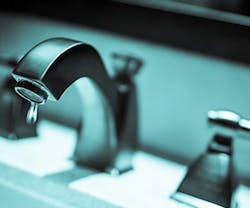Fresh off the heels of a water audit? Congratulations – addressing the wear and tear, biofouling, and other efficiency-destroying issues will no doubt save money and water for your facility. But did you realize there are additional savings beyond a basic audit?
With a little more analysis, you can turn the data you’ve already collected into actionable items.
Gather Data
Start by compiling data from previous basic audits, such as the location, type, and usage frequency of all water fixtures in the building. Then use that information to embark on a three-step comprehensive audit.
“A basic audit for much of a facility is typically more qualitative than quantitative. For something like a cooling tower, it isn’t much more than a visual check, in the spirit of keeping things simple,” says Robert Wanvestraut, senior conservation analyst for South Florida Water Management District. “For an advanced audit, you’re looking at things like how many cycles you’re running your cooling tower at and how much water you’re putting through the meters.”
1) Evaluate flow, flush, and usage rates. Go back to every fixture listed in the documentation from your previous audit and compare actual performance to rated performance. This will indicate which fixtures require maintenance or replacement.
For example, your toilet may be rated at an efficient 1.6 gallons per flush (gpf), but it could actually be using more, Wanvestraut explains. Simple tests, such as timing the length of a flush and multiplying by the typical commercial valve flush rate (0.42 gallons per second), will reveal whether the toilet is performing as it should. A flush that lasts longer than 4-5 seconds indicates that the toilet has lost some efficiency.
For faucets and showerheads, use containers with volume markings, such as measuring cups or flow-gauge bags.
“You might need to replace the diaphragm inside the flush valve,” explains Wanvestraut. “You could have a 1.6 gpf toilet, but when one of your staffers went to the hardware store, they bought the innards for a 3.5 gpf toilet and it fits because the parts can be interchangeable. Sometimes mineral precipitation or other impurities from the water will accumulate and cause the weep hole in the flush valve to stay open longer than it should, so it’s using 2.5 gpf.”
Have a commercial kitchen? Don’t forget to examine sources like the ice machine, dishwasher, and pre-rinse spray valves. Manufacturers can supply information like gallons per dishwasher rack or ice production rate – you’ll need to figure out how much these fixtures are used.
2) Reach beyond low-hanging fruit. After addressing leaks and other issues that can lead to inefficiency, it’s time to look past what you can see. For instance, the cooling tower example assumes that you’ve already dealt with algae, biofilm, and corrosion. Now you’re ready to look at reducing the heat load or increasing the concentration ratio.
3) Determine water’s true cost. Your water bill isn’t limited to monthly utility fees. Quantify water’s real cost and potential savings by factoring in the price of cooling tower cleaning chemicals, waste costs for biosolids, and energy used to heat or cool water, Wanvestraut recommends.
Tips and Tools
To help collect the necessary numbers, consider investing in submeters. These are becoming more common for water, especially for buildings aiming for green certifications, and can be useful in detecting leaks or high usage rates, says Becky Fedak, an engineer for the Brendle Group, a sustainability consultancy.
“An obvious opportunity would be if you’re suddenly seeing significant usage peaks or your use is higher than you’d anticipate for a certain time of year,” Fedak says. “Seeing abnormalities in utility bills can be a trigger to hone in on what’s going on. Otherwise, the savings tend to be hidden.”
Need additional guidance? The EPA’s WaterSense program – essentially ENERGY STAR for water – offers scores of free resources as part of its WaterSense at Work manual, including worksheets to help structure your water management plans.
South Florida Water Management District’s newly reissued Water Efficiency and Self-Conducted Water Audits at Commercial and Institutional Facilities Guide can also complement your toolkit – it’s applicable to all states and comes with free spreadsheet calculators to make the process easier. Take a look at www.sfwmd.gov/conserve (click on “Businesses”).
Find Opportunities for Further Savings
Armed with a new data set, you can now focus on improvements. Replacing faucets and fixing malfunctioning toilet valves are good places to start due to the quick payback, Wanvestraut notes. Your biggest source of savings, however, varies depending on your building type and population.
“For example, schools are areas where restroom use is high,” explains Fedak. “A building like a liquor store, where there are a lot of people coming through but not much restroom use, is going to use more water on the cooling side. For larger office or retail buildings, the biggest opportunity is generally irrigation. Consider rain or soil moisture sensors and landscape choices like going from turf grass to more xeriscape opportunities.”
Janelle Penny [email protected] is associate editor of BUILDINGS.
About the Author
Janelle Penny
Editor-in-Chief at BUILDINGS
Janelle Penny has been with BUILDINGS since 2010. She is a two-time FOLIO: Eddie award winner who aims to deliver practical, actionable content for building owners and facilities professionals.

